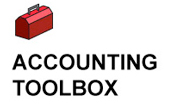Accounting and technology have always worked together. When visiting an Internet website, click on the "about us" to evaluate the resource and click on newsletters and other community options to learn how the site might provide continuing updates on topics of interest to your academic and career goals. Accounting's logical and applied mathematical structure has used available technology, be it an abacus or the latest computers, to support large-scale revenue-forecasting models. Technology can be broken into three categories:
(1) those applicable to classical general ledger and financial reporting
(2) those that support an entire enterprise resource program (ERP) or customer resource management (CRM) system
(3) those applicable to revenue and economic forecasting
1. General Ledger and Financial Reporting
General ledger and financial reporting rely on readily available, commercially off-the-shelf (COTS) packages that combine all the accounting functions from journal entries through financial statements. COTS packages are typically classified in two ways: (1) by the organization's size and technical sophistication, and (2) by industry-specific needs.
Selecting the right COTS package usually involves evaluating alternatives until the right fit is determined.
How to Choose Business Accounting Software
Discusses how to select a small-business accounting package, or the option of using a hosted site.
The best way to begin selecting a COTS package is to ask the following questions:
- How large is the organization, either by sales, products sold, or employees?
- Is the organization expected to grow, downsize, or remain the same?
- How many locations is the organization in, and will that change?
- Are there industry requirements that must be met?
- Are there auditor recommendations or material findings that must be resolved?
- How much accounting or technology knowledge do the users have?
- What kind of technology infrastructure is needed to support the application?
- How integrated must the data be? For example, must sales data be used by manufacturing or merchandizing? System integration promotes both efficiency and enhances reliability.
What We Know Now: A Look into Lessons Learned Implementing Federal Financial Systems Projects presents an example of the partnership of private practice and government operations. Access additional information at the web site
http://www.businessofgovernment.org/report/what-we-know-now-look-lessons-learned-implementing-federal-financial-systems-projects
A summary of the ten principles related to implementing financial systems projects is presented at the web site
http://www.businessofgovernment.org/sites/default/files/Forum_FM.pdf
2. Enterprise Resource Programs or Customer Resource Management Systems
Enterprise Resource Programs (ERP) or Customer Resource Management (CRM) systems are specialized software that integrates accounting into an overall management program. ERP and CRM systems used to be available only to large organizations; however, in the last few years smaller, integrated packages have become available. An ERP or CRM provides an integrated approach to data collection (enter once, use many times) while at the same time exponentially increasing system complexity. An ERP focuses on the internal workings needed for an organization; a CRM integrates customer information with enterprise data.
Industry-specific accounting software packages are also available.
For example, QuickBooks Premier or Sage Peachtree Quantum Accounting Software.
QuickBooks and Peachtree offer accounting software for small manufacturing, contractors, not-for-profit, and retail operations.
For service industries that rely on billing hours for revenue, the major professional associations provide guidance:
AMA PATH
For the American Medical Association on managing a practice.
Legal & Law Firm Accounting Software
Provides similar advice for both the accounting and legal professions.
The larger accounting systems have specialized add-on packages that support specific industries.
SAP Services & Support for Manufacturing
This is one example that supports manufacturing.
3. Revenue and Economic Forecasting
Revenue or economic forecasting technology can come in the form of spreadsheet software or can be as complex as advanced data modeling tools such as SAS.
Basic spreadsheets can provide an understandable, easy-to-use revenue and expense forecasting model.
Microsoft Excel 2010 Step by Step, a book, is available at Barnes and Noble.com or at Amazon.com and offers a good basic explanation of Excel and its capabilities. For most small- to mid-sized organizations, an Excel spreadsheet can be used to forecast revenues and associated expenses (both fixed and variable) and to perform "what if" scenarios.
Moving into more complex modeling requires a much better understanding of economics and statistics. Suggested UMUC courses are found in the section under Critical Thinking. Technological tools are much more complex.
Books to Consider
To obtain a basic understanding of economic forecasting, there are books available through Amazon.com, Barnes and Noble.com, and the UMUC library. Among those that may be of assistance are:
Handbook of Economic Forecasting
Executive Economics: Forecasting and Planning for the Real World of Business
To perform these more complex economic analyses, it is best to work with a more complex modeling tool. These can include:
SAS | Business Analytics and Business Intelligence Software
Accountants should regularly receive updates on changes to accounting software and available forecasting options. This includes:
Information Technology - Information Security – Information Assurance | ISACA
ISACA can provide updated information on accounting and auditing information technology.
American Institute of CPAs
This site will also provide updates on information technology.
The Institute of Internal Auditors
Integrates technology and the management of risk and the internal audit function.
Fraud and Internal Auditing
Fighting High-tech Fraud From the Institute of Internal Auditors (IIA).
Toolkits and information on fraud can be found by searching on the following websites:
Fraud, auditing, and technology, including Accounting Information Systems (AIS), intersect, as explained in comments above. Search for these terms and evaluate the sources before proceeding with your work plans.
